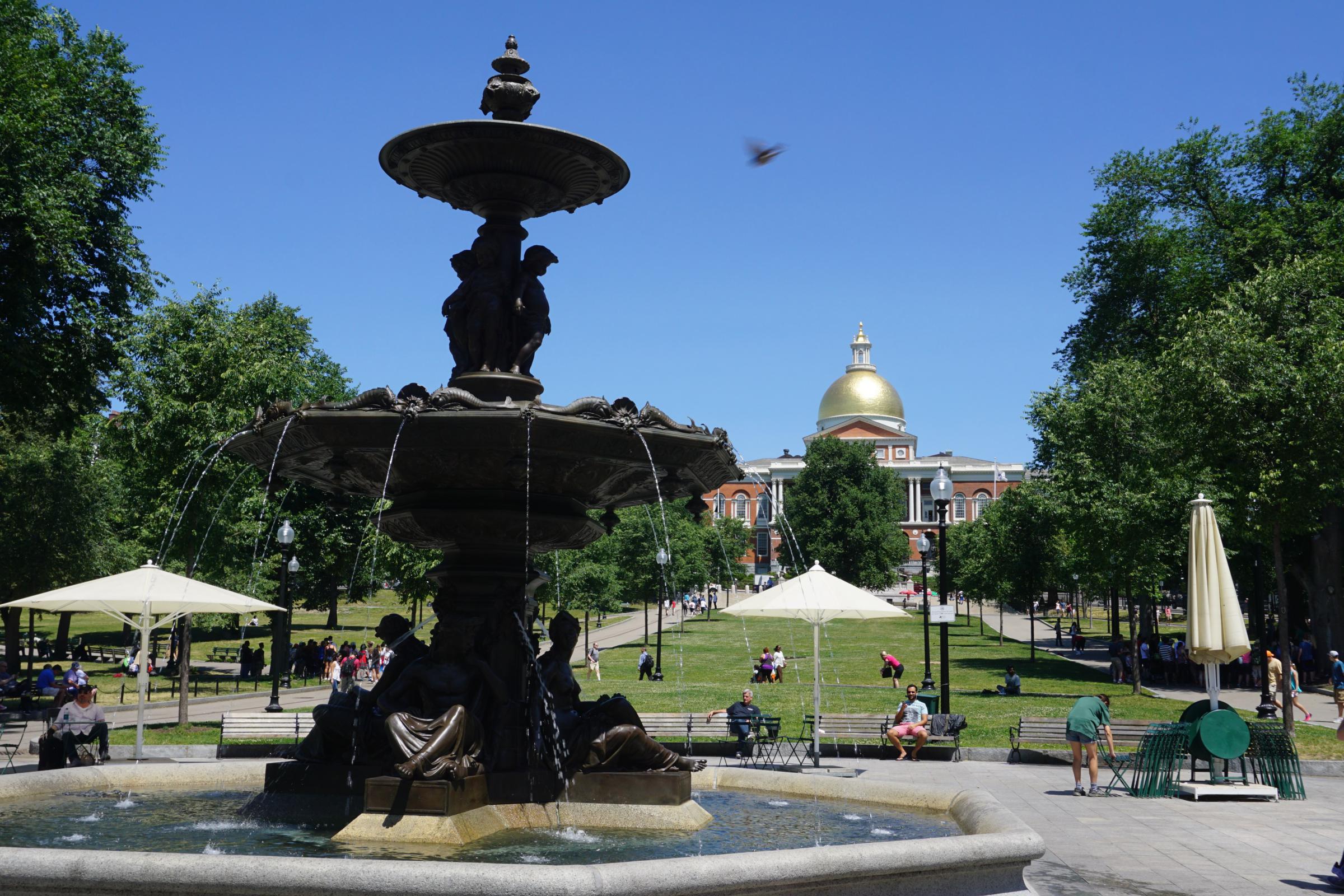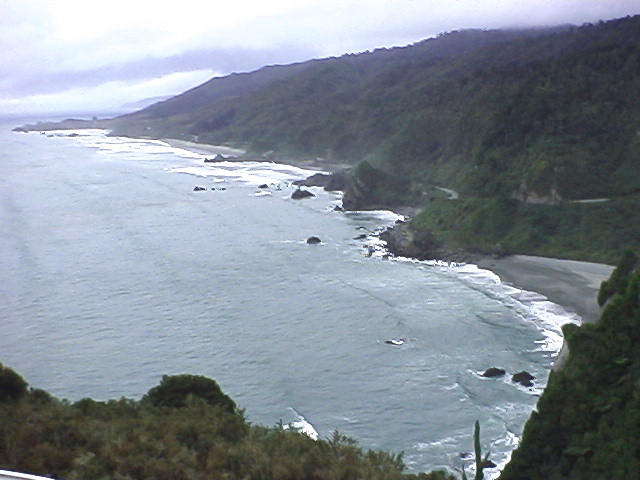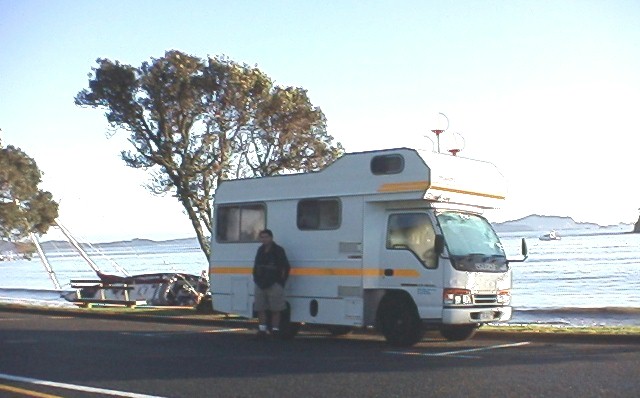
Around the World 1998; North Island New Zealand
Note; this post is recreated from the original wired2theworld website post with the dates below. The old posts were reformatted in 2018 for the 20th anniversary of wired2theworld. As much as possible, the content is unchanged and unedited from the original, only some formatting, spelling, and link errors have been corrected.
NEW ZEALAND, North Island: In The Campervan…
US$1=NZ$1.98
Kristina’s Journal:
September 19, 1998 Keep To the Left and Stay Calm!
Of course, we forgot our olives and Lebanese bread in the refrigerator. We hope it was a nice parting gift to our gracious hosts in Auckland.
We picked up the campervan on the morning of the 16th. As he was driving us to the depot, Bryan gave us the best advice possible under the circumstances, “Keep to the left and stay calm!” It became our mantra. For the first day, we repeated it every five minutes. This is necessary, due to 15 years of cultural brainwashing telling us that we must drive on the right side of the road. It’s very nerve-wracking to be on the left, the brain keeps telling you there’s something wrong here.
After getting complete instruction on the workings of the campervan, the water tank, the propane tanks, the batteries and the toilet, we were off! First stop, the grocery store to fill up on the necessities of life, food, wine, and toilet paper. The large supermarkets here are quite nice, excellent produce, nice looking meat, and of course, great New Zealand and Australian wines.
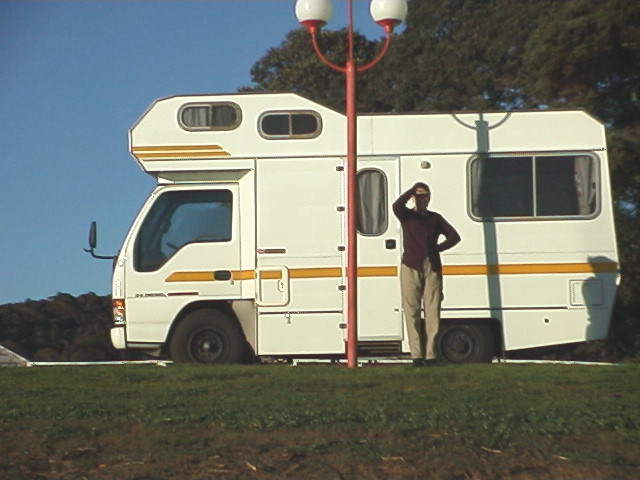
By the time we had perused the entire store and brought our loot out to the van, it had begun to rain. Unfortunately, this was just a preview for the next three days. Try driving a small house, on the left, in the howling rain and wind, down a two lane highway in the dark. To his credit, David did wonderful, though he was quite a bit nervous. We just took turns repeating the mantra.
That night we drove north from Auckland, up to the Bay of Islands area. We parked on the side of the road, next to a beautiful beach in the town of Paihia and camped there for the night. One of the nice things about New Zealand is that it is legal to camp anywhere along the roads, unless there is a sign specifically prohibiting it (which is rare).
The campervan is totally self-contained, which means we had plenty of water and power to stay the night. Another nice thing is that the campgrounds here, called “holiday parks”, are mostly privately owned and are very nice and clean. Most offer power hook-ups, water, toilets, showers, kitchens, and some have BBQ’s, game rooms, and other facilities. They charge a fee per person, instead of per vehicle like the US. There are also government run campgrounds, with minimal facilities, which are free, but we actually haven’t seen any yet.
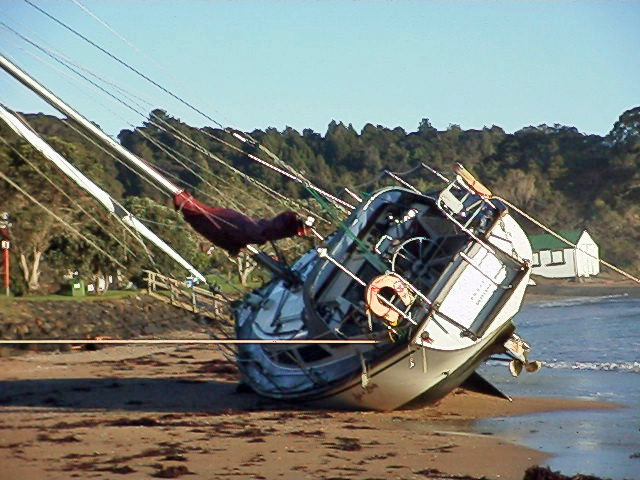
We seem to be traveling at a good time of year, Spring. It’s not high season yet, summer, December through February, which sounds like it gets very crowded here. Thankfully, there aren’t tons of tour buses on the roads and no crowds at the sights. The tradeoff is that it’s still very cold here and we’ve had quite a bit of rain. On the other hand, this rain leads to rolling green hills, lush forests, and Spring gives way to lambing season, with thousands of weeks old lambs scampering about. Also, Spring is allergy season, and I’ve found myself sneezing and wheezing the whole time here. Ah, a small price to pay.

Our next day in the in the Northland, as they call it here, was spent in search of the Kauri tree, the ancient “giver of all life” to the Maori. The Kauri tree is often compared to the California redwood. We drove through the Waipoua Kauri forest on the
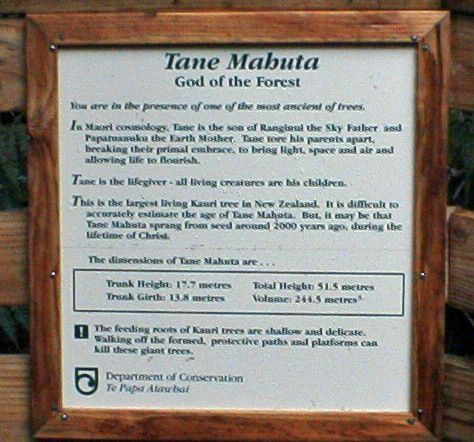
September 21, 1998 Glowworms and the Agrodome
The next day we headed toward the Waitomo Glowworm Caves. Yep, that’s right, worms in caves, the stuff of which nightmares are made. Actually, it wasn’t all that bad, but a bit overpriced for what you get. It was NZ$17 per person for a guided tour of the caves including a little underground boat ride to view the famous glowworms in all their glowing green glory.
The glowworm is actually the maggot form of a fly that suspends silk-like threads and then glows green to attract its prey (other flies and mosquitos). These caves seem to attract them in the thousands due to the river that runs through the bottom. Unfortunately, you are subjected to perhaps the most boring guide on the planet who takes you through the caves to a small boat.
The caves themselves are pretty interesting, limestone formations of stalactites and stalagmites. There is one really large cave room called the Cathedral, about 50 feet high. The boat ride takes you into darkness and then the “milky way” of glowworms. This would be great if the cavern was more than 30 feet long. Instead, the guide just takes you back and forth, back and forth, along the cavern. Then it’s over and you get to walk out through the caves the way you came in. All in all, interesting, but not all it’s cracked up to be. That night we headed toward Rotorua Lake, the beginning of the thermal region and center of Maori culture for New Zealand. We stayed in a nice campground right on the lake called Lakeside Thermal Holiday Park. They have their own thermal pools.
The following morning we went to see some of the main attractions in Rotorua.

The first among them was the Agrodome. This at first appears to be a really tacky farm exhibit but proved to be one of the highlights of the trip so far. They are known for their “World Famous Live Sheep Show!” (sorry, nothing kinky here folks). Remember, there are about 16 sheep for every person here in New Zealand, so this is big business. Before the show, you get the chance to look around at all the different breeds up close and look at some of the lambs in the nursery. This show is where they put all 19 of the different breeds of sheep up on stage, talk about their differences, show how they are sheared, how well the sheepdogs are trained and let the audience feed the baby sheep. These sheep are all males, rams, and are very well trained.
The MC, who is a professional sheep shearer, is very likable and funny. We learned that some sheep are raised for their wool, some for the meat, and different ones are raised on the North and South Islands, given the fluctuation in climate. The sheepdogs are amazing as well; they are trained to walk the backs of the sheep out on the farm when thousands of sheep are packed tightly together. I even got my picture taken with the sheep in the show. I know the sheep look fake, but they were real!
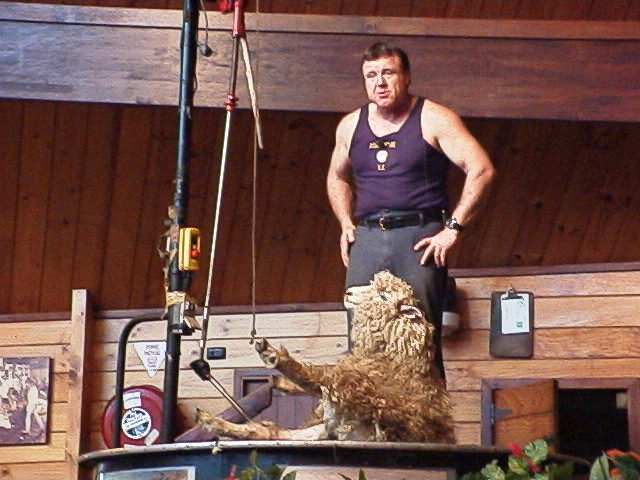
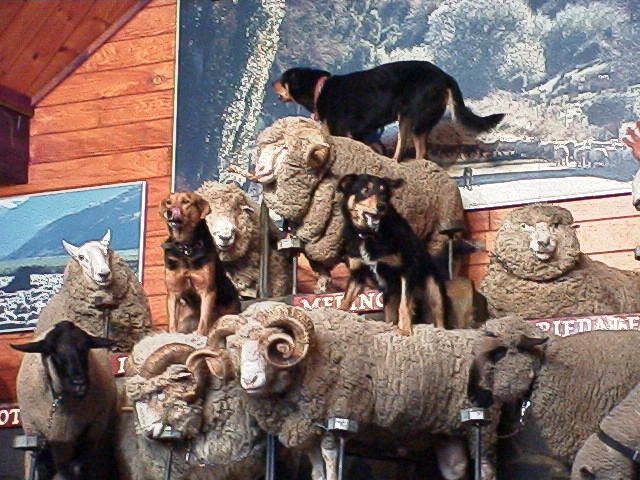
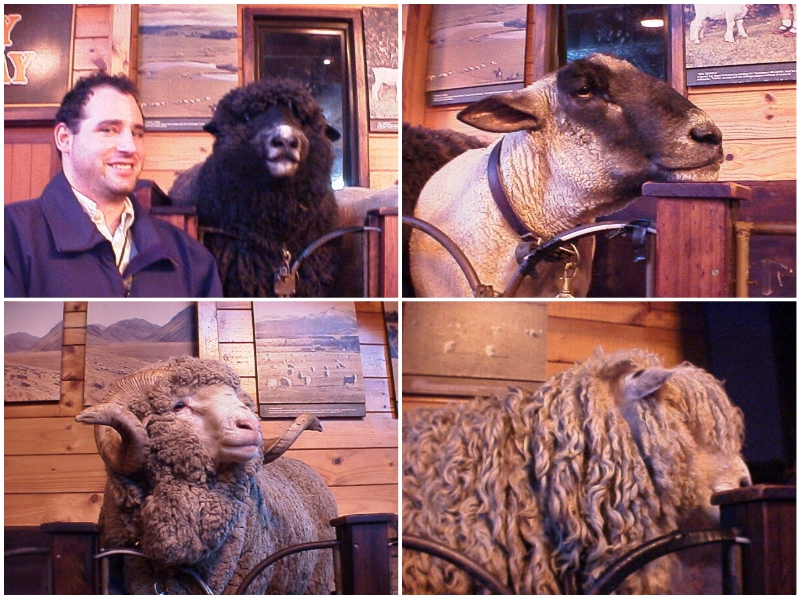
Afterward we took the optional, extra, tour of the working farm, which was also fun and informative. We saw kiwi orchards, herds of sheep and deer which we fed, and all different sorts of cows. It was especially nice that we are here in spring because it’s “lambing” season which means al the babies have been born within the last three weeks and are they precious! We were told that the breed of sheep they raise on the farm there yields twins 9 out of every 10 births! So there were lots of mama sheep with two little lambs following behind.
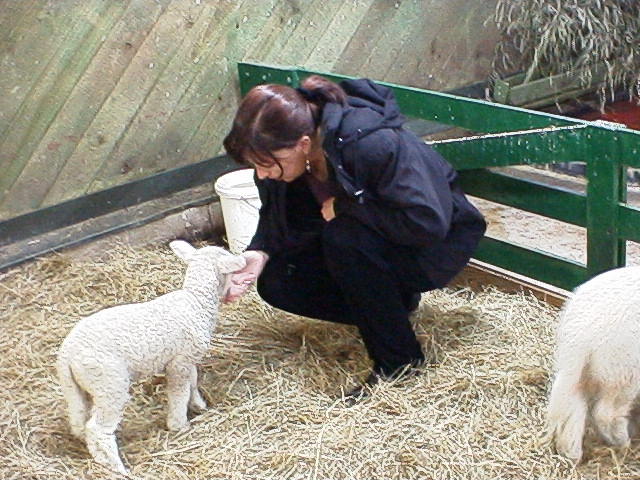
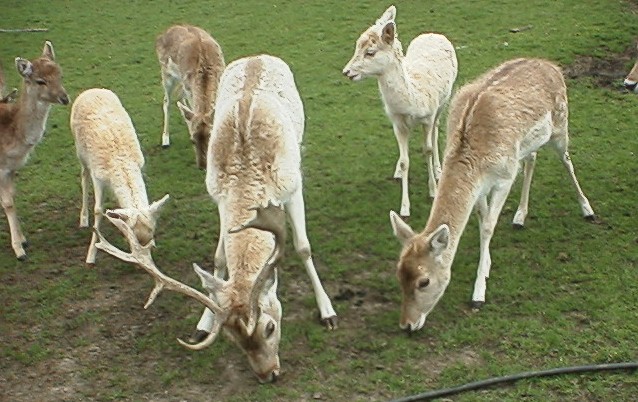
After the Agrodome it was getting late, so we decided to head down to Lake Taupo for the night. We spent the night at the Great Lake Holiday Park (where they have a very friendly 15-year-old grey cat named Ben) and the next morning went off to see Wairakei Park which is just north of Lake Taupo. Wairaki Park is based around a Geothermal power plant and there are many interesting things to see and do there.
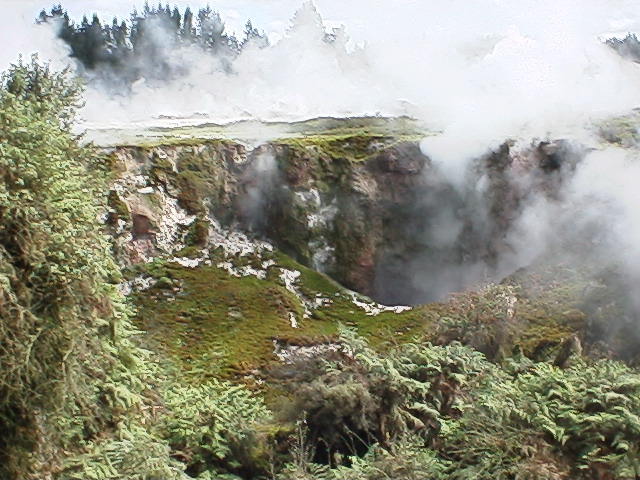
The first thing we did was check out Huka Falls which is not a huge waterfall (only about 70 feet), but impressive in its power (62,000 gallons per second) and its beautiful clear blue color. Huka means “foaming” in Maori and the bottom churns like a big washing machine. There is a bridge that goes across it and you can walk along a path to get a great view.
Next, we went over to see the Craters of the Moon thermal area. This is an area about one square mile where steam rises from the ground, mud bubbles up in pools, and huge craters have been formed by giant sinkholes from deep underground. What’s really interesting about this is that it was all created relatively recently. In the 1950’s when the geothermal energy plant was built, the harnessing of all this power caused blockages underground which in turn caused the eruptions in the surface a few miles away. The entire area is very unstable and it is said that to stray off the paths is to risk stepping into a new sinkhole and severely burning yourself.
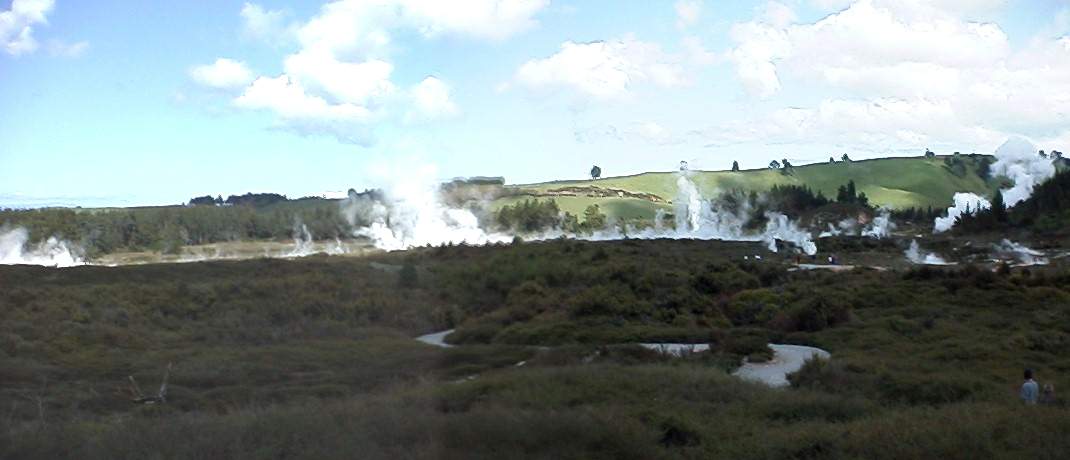
The next thing we did was go to the Prawn Park, where you can “meet ’em, greet ’em and eat ’em”. At first I thought this was just too much and had to be a joke, but no, it’s real. It’s the world’s only geothermally farmed prawns. We even went on the tour to see how they farm Malaysian prawns in geothermally heated water. The farm is even environmentally correct in that it uses runoff steam from the power plant next door to heat the river water, and then cleans and recycles its’ water after it drains the ponds the prawns grow in. OK, interesting enough, then we had lunch. Had to, the temptation was just too great. The prawns were good, served whole, peel and eat. We also had good Thai curried prawns over rice.
After that it was time for a soak in the Taupo Hot Springs. This is a mineral pool complex with private pools for soaking, big public pools, kids pool, and even a hot water slide. The water comes directly out of the ground so hot it would burn you and runs through a series of channels to cool it down before it reaches the pools. For only $NZ8 per person you can soak as long as you want in a private pool and than use any of the other pools. So we did and it was wonderful. Those of you that know David know that he will stay in hot water until he prunes up and then longer; he was in heaven.
The food here has also been very good, though grocery stores vary in quality. I’ve actually been cooking every night which is quite a change of pace for me (for those of you that don’t already know, most chefs don’t cook at home, we’re too tired, or we have no time). I’ve made some good lamb chops (felt a little guilty, but when in Rome…) and tonight we had some great local NZ Salmon, pan roasted with a grapefruit butter sauce. The little gas stove in the camper van has two burners, but works quite well, and even has a small broiler underneath that does a great job once I got used to it. The campervan is also quite convenient for lunch. We just pull over whenever we get hungry, hop in back and have sandwiches. Saves time and money. We do miss out on the local food though.
Speaking of local food, one of the more interesting items is the meat pie, which I gather is an old British holdover. You’ll find shops (of varying quality), from the small bakery to the fast food outlet, and even grocery stores, selling meat pies will all sorts of different fillings. They are usually the size and shape of what we know in the US as the “chicken pot pie” of the frozen variety. The difference is that the pastry is a little thicker and does not require a container to hold it. It is meant to be eaten on the go, held in the hand. The filling is also a bit thicker and can have meat, chicken, vegetables, curry, cheese, seafood, in any combination imaginable. Our first try was horrible, too pasty, but others we’ve had since have been excellent. If you come to New Zealand you must try them, they make a great snack or light meal and only cost about NZ$2-3 each.
September 22, 1998 Success in a Phone Booth…
Well, sort of. When we arrived at Wellington campground today we decided to try using the acoustic coupler in a phone booth to access the internet. For those of you that don’t know, an
Today we went to the new Wellington
We had a nice meal tonight; I made braised beef shank over
Kristina and Dave’s Traveling Bar… A note here about New Zealand wines; they’re very good. Also, given the great exchange rate, they’re incredibly affordable. None of the wine we’ve purchased has been over NZ$13 a bottle ($6.50 US), most have been in the NZ$10 range, and all have been excellent table wines. Of course, you could spend more, but we can’t. Our traveling bar consists of a bottle of Port we bought at the Duty Free in Fiji, and usually an open bottle of red or white or both. We’ve had some very nice Cabernet/Merlot blends, which are very popular here. We bought a nice one today at the Mission Winery in Hawkes Bay. They have just begun exporting to the US, so look for it soon.
THINGS WE DID TO SAVE MONEY:
1. Avoided the expensive “Polynesian Spa” in Rotorua in favor of the less expensive, less touristed Lake Taupo Hot Springs
2. Ate breakfast, lunch, and dinner in the campervan.
3. Tasted wine in the wineries, but did not buy.
THINGS WE SPLURGED ON:
1. Had lunch at the Prawn Park Restaurant
2. Good food for the “breakfast, lunch, and dinner” in the campervan.
3. OK, we bought a bottle here and there, buy not expensive ones.
4. NZ$3 in an internet cafe in Wellington to check our site on a bigger screen (looked ok, they didn’t have our font, “technical”.
You can see the original 1998 post here.
Related Posts
